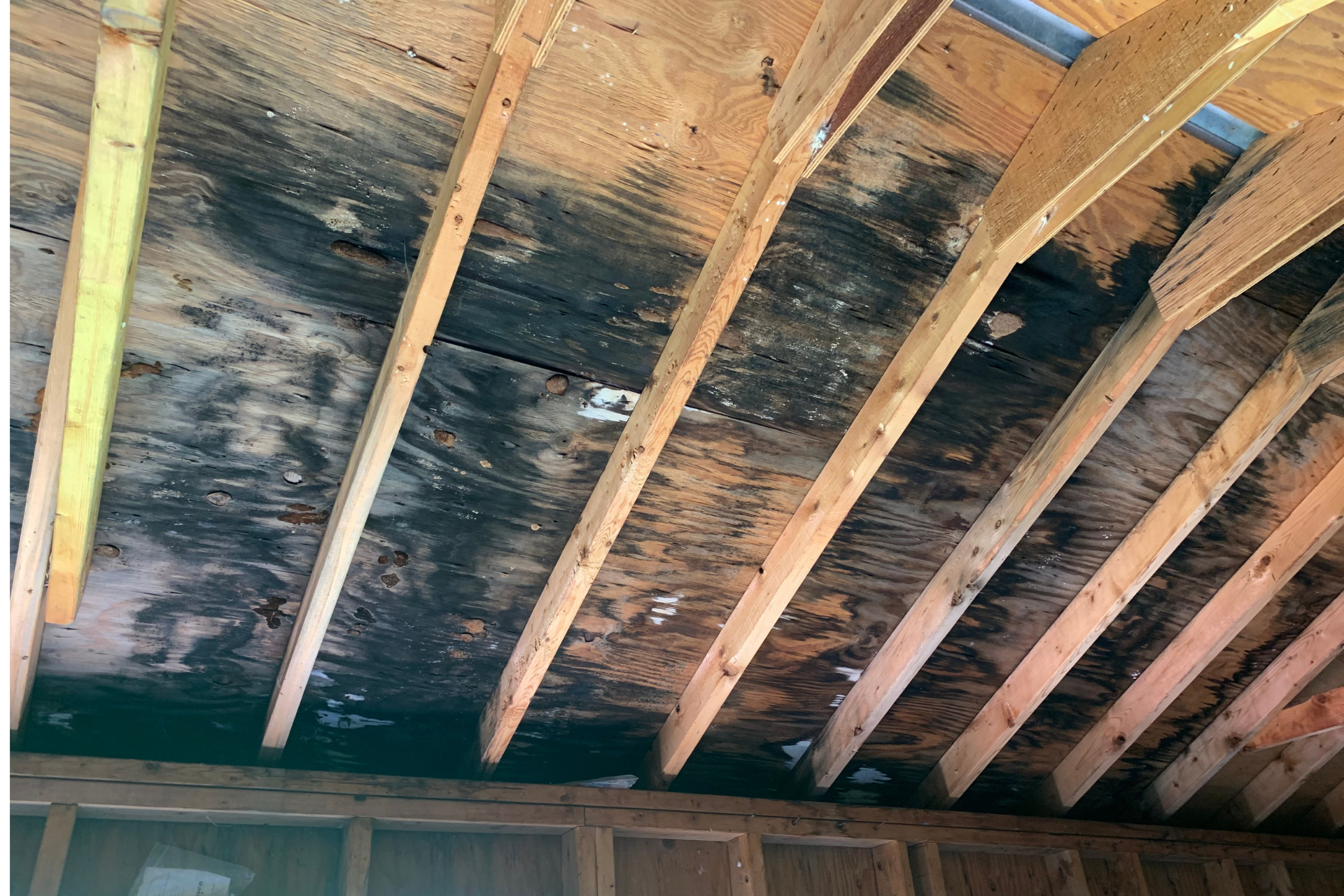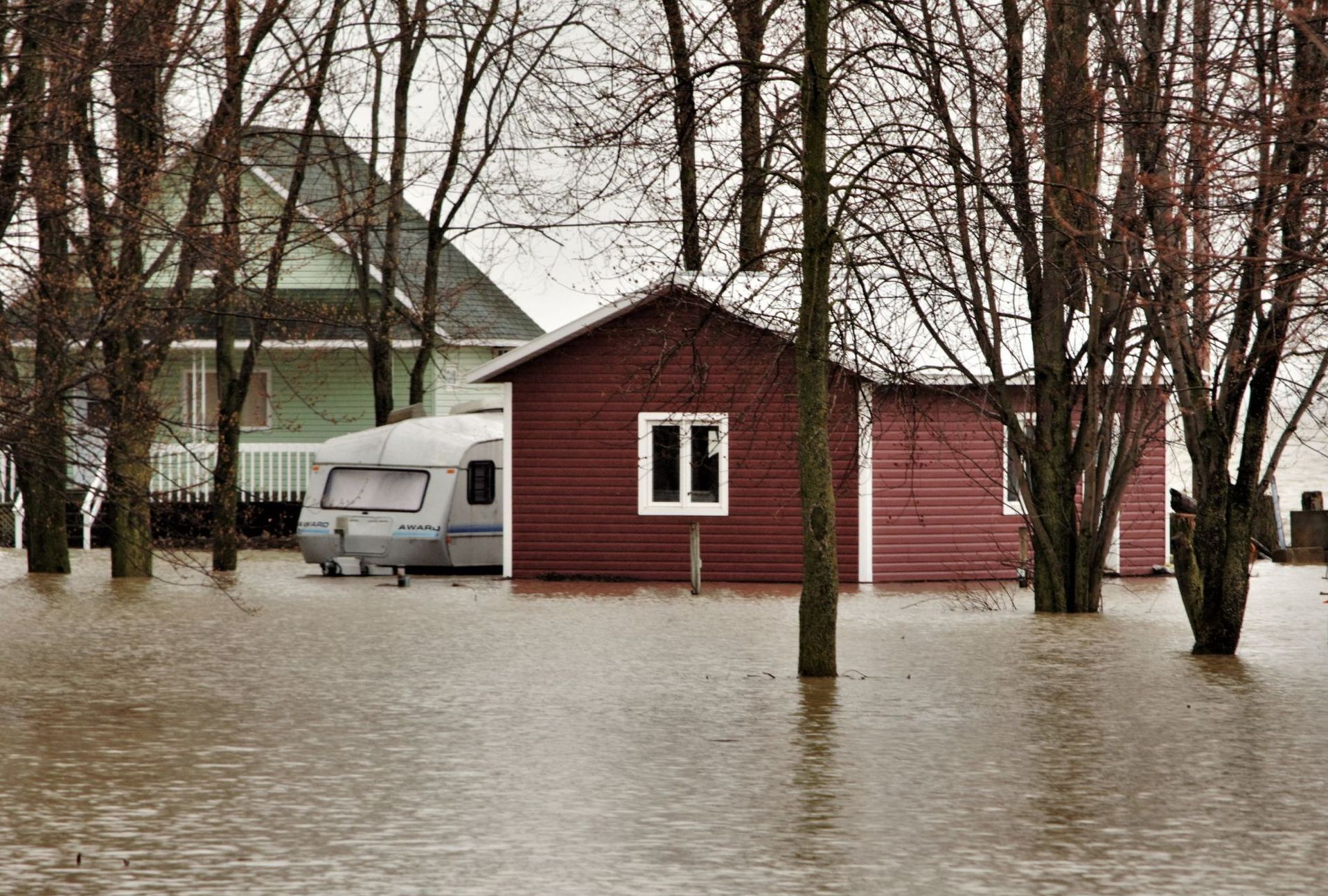Expert Water Damage Restoration Tips
DryGuard Restoration Blog
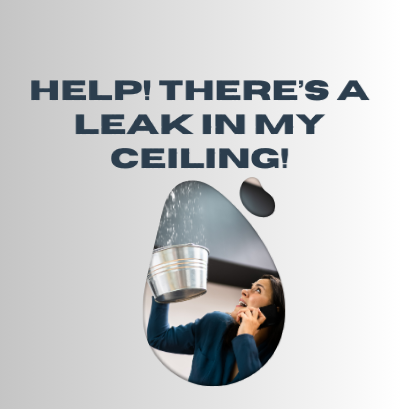
01 May, 2024
Dealing with a leak in your ceiling can be stressful, but fear not! Our latest blog post from DryGuard Restoration offers expert advice on what to do when you discover a leak, including how to identify the source and the importance of swift action. Learn about our advanced leak detection services and how we can quickly and efficiently repair any damage. Don't let a leak ruin your day – read our blog and contact DryGuard Restoration for reliable water damage restoration services in Fort Worth and surrounding areas!
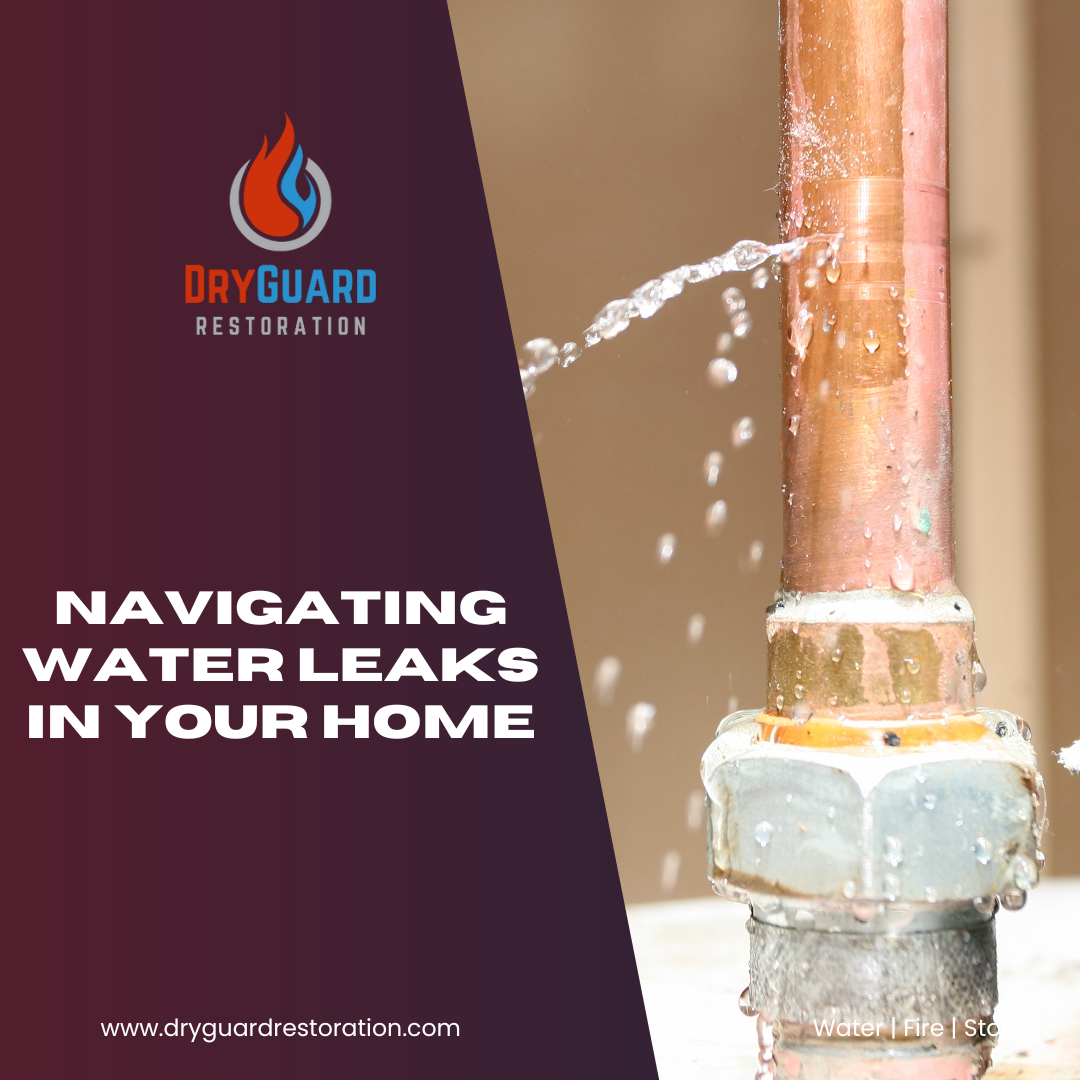
12 Mar, 2024
Water leaks are an unfortunate reality for many homeowners in the Dallas-Fort Worth area, whether they're caused by burst pipes, roof leaks, appliance malfunctions, or natural disasters. When water infiltrates your home, it can cause extensive damage and disrupt your life in an instant. That's where DryGuard Restoration steps in—to provide fast, reliable, and comprehensive water remediation services to homeowners in need. Here's how we can help you navigate water leaks and restore peace of mind: Emergency Response: At DryGuard Restoration, we understand that water emergencies can happen at any time, day or night. That's why we offer 24/7 emergency response services to promptly address water leaks and minimize damage to your home. Our team of experienced professionals is on standby to respond to your call and deploy to your location quickly. Thorough Inspection and Assessment: Upon arrival, our certified technicians will conduct a thorough inspection and assessment of the water damage to determine the extent of the problem and develop a comprehensive remediation plan. We use state-of-the-art equipment, such as moisture meters and thermal imaging cameras, to identify hidden moisture and ensure no area goes unchecked. Water Extraction and Drying: Using powerful extraction equipment, we'll remove standing water from your home and begin the drying process immediately. Our industrial-grade air movers and dehumidifiers help accelerate drying times and prevent mold growth, ensuring your home is returned to a safe and healthy environment as quickly as possible. Mold Remediation: Water leaks can create ideal conditions for mold growth, posing additional health risks and structural concerns. At DryGuard Restoration, we're equipped to handle all aspects of mold remediation, from containment and removal to sanitization and prevention. Our certified mold remediation specialists adhere to industry best practices to ensure thorough and effective mold mitigation. Structural Repairs and Restoration: Once the water has been extracted and the affected areas dried, our team will begin the process of restoring your home to its pre-loss condition. From repairing damaged drywall and flooring to replacing insulation and structural components, we'll work diligently to rebuild and restore your home with precision and care. Preventative Measures: In addition to remedying the immediate water damage, we'll also implement preventative measures to reduce the risk of future water-related incidents. Whether it's repairing faulty plumbing, improving drainage systems, or recommending waterproofing solutions, we'll help safeguard your home against future water leaks. When disaster strikes in the form of a water leak, you can count on DryGuard Restoration to be your trusted partner in restoration and recovery. With our comprehensive range of water remediation services and commitment to excellence, we'll help you navigate the challenges of water damage with confidence and peace of mind. Don't face water leaks alone—contact DryGuard Restoration today for prompt, professional, and compassionate assistance you can trust.

08 Mar, 2024
Discovering standing water in your home is a homeowner's worst nightmare. Whether it's from a burst pipe, a leaky roof, or a flooded basement, the presence of water can cause significant damage and pose serious health risks if not addressed promptly. At DryGuard Restoration, we understand the urgency of water emergencies and are here to guide you through the steps to take if you find standing water in your home: Safety First: Before attempting to address the standing water, prioritize your safety and that of your family. Turn off the electricity to the affected area to prevent the risk of electric shock. If the water level is high or there is potential for contamination (e.g., sewage backup), evacuate the area and avoid contact with the water. Identify the Source: Determine the source of the standing water and take steps to stop the flow if possible. Shut off the main water supply to your home to prevent further water damage from plumbing leaks or bursts. If the water is coming from outside, such as heavy rainfall or flooding, take measures to divert water away from your home if it's safe to do so. Assess the Damage: Once it's safe to enter the affected area, assess the extent of the water damage. Take note of any structural damage, saturated materials, and potential hazards. Document the damage with photographs or videos, as this will be useful for insurance claims and restoration efforts. Remove Standing Water: Use a wet/dry vacuum, mop, or towels to remove as much standing water as possible from the affected area. Be thorough in your efforts to prevent water from seeping into building materials and causing further damage. Consider renting or hiring professional-grade equipment for large-scale water removal jobs. Dry Out the Area: Proper drying is essential to prevent mold growth and further damage to your home. Open windows and doors to promote airflow and use fans and dehumidifiers to expedite the drying process. Remove wet carpets, rugs, and furniture from the area, if possible, and place them in a dry, well-ventilated space to dry thoroughly. Mitigate Mold Growth: Mold can begin to grow within 24-48 hours of water damage, so it's crucial to act quickly to prevent mold infestation. Use mold inhibitors or antimicrobial solutions to treat affected surfaces and materials. Consider hiring a professional mold remediation company like DryGuard Restoration to ensure thorough mold mitigation and prevention. Contact Your Insurance Company: Notify your homeowner's insurance company as soon as possible to report the water damage and initiate the claims process. Provide detailed documentation of the damage and keep records of all communication with your insurance adjuster. Seek Professional Help: While you may be able to handle small water damage incidents on your own, significant water damage requires professional expertise and equipment. Contact a reputable water damage restoration company like DryGuard Restoration to assess the damage, develop a comprehensive restoration plan, and restore your home to its pre-loss condition. Finding standing water in your home can be overwhelming, but with swift action and expert assistance from DryGuard Restoration, you can minimize the damage and get your life back on track. Don't delay—contact us immediately for fast, reliable water damage restoration services you can trust.
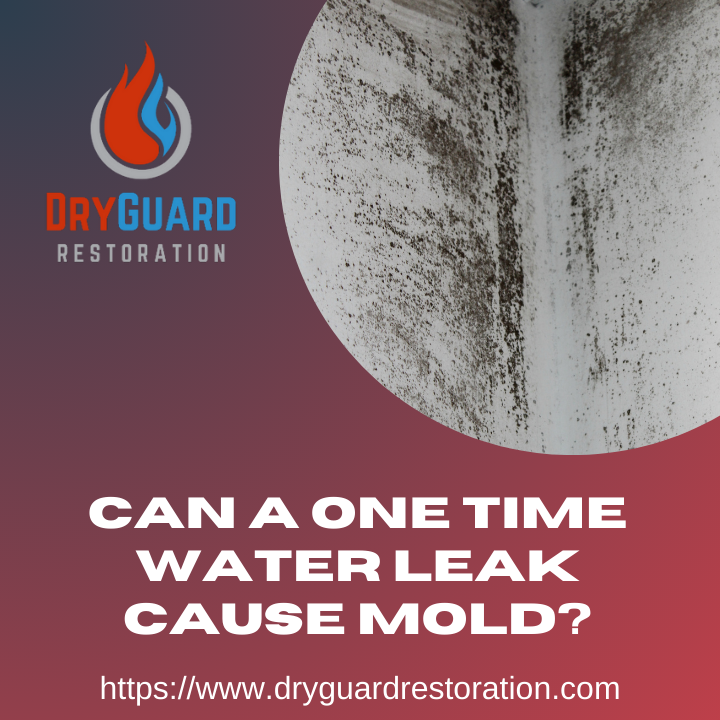
21 Feb, 2024
As a homeowner or property manager, discovering a water leak in your space can be alarming. Beyond the immediate concern of water damage, there's often a lingering worry about the potential for mold growth. In this blog post, we'll delve into the question: Can a one-time water leak cause mold? Understanding this link is crucial for taking prompt action and safeguarding your property's integrity and occupants' health. Understanding Mold Growth: Mold is a type of fungus that thrives in moist environments. While it's a natural part of the environment, indoor mold growth can pose significant health risks and structural concerns. Mold spores are present in the air and can settle and proliferate in areas with sufficient moisture and organic material to feed on. The Impact of Water Leaks: Even a one-time water leak can create the ideal conditions for mold growth. Whether it's a burst pipe, a leaking appliance, or a roof leak, any source of water intrusion can introduce moisture into your property. This moisture, if left unchecked, can seep into building materials such as drywall, wood, or insulation, providing a conducive environment for mold spores to germinate and spread. The Role of Timing and Conditions: While mold growth can occur relatively quickly after a water leak, several factors influence the timeline and severity of mold infestation. These include: Moisture Levels: High humidity or prolonged dampness can accelerate mold growth, even from a one-time water leak. Temperature: Mold thrives in temperatures between 77°F and 86°F (25°C to 30°C), making indoor environments comfortable breeding grounds if left untreated. Organic Material: Building materials such as drywall, wood, and carpeting provide ample nutrients for mold to grow and colonize. Prevention and Remediation: To mitigate the risk of mold growth following a water leak, swift action is crucial. Here's what you can do: Prompt Detection: Act quickly to identify and address water leaks as soon as they occur. Thorough Drying: Properly dry affected areas and materials to prevent moisture buildup and inhibit mold growth. Professional Assistance: Seek the expertise of a water damage restoration company like DryGuard Restoration for comprehensive assessment, mitigation, and remediation services. While a one-time water leak may seem like a minor inconvenience, it can indeed lead to mold growth if not addressed promptly and effectively. By understanding the link between water intrusion and mold proliferation and taking proactive measures to mitigate risks, you can protect your property and ensure the health and safety of its occupants. For expert assistance in water damage restoration and mold remediation, trust DryGuard Restoration to safeguard your space and restore it to its pre-damage condition. What If I Discover Mold In My Property? The state of Texas has some specific laws and regulations when it comes to mold remediation in residential and commercial properties. Additionally, there are strict guidelines for licensing of mold remediation professionals. If you discover mold within your property it is helpful to understand the basic laws and requirements to ensure you receive the appropriate service, reduce potential health risks to occupants, and minimize future liability. Property owners and managers should verify the license status of mold remediation contractors before hiring them to ensure they are qualified and authorized to perform the work. Texas Department of Licensing and Regulation (TDLR) Key Rules and Requirements for Licensed Mold Remediation Professionals in Texas: Licensing Requirements: In Texas, individuals or companies engaged in mold remediation for compensation must hold a Mold Remediation Contractor license issued by TDLR. To obtain this license, applicants must meet certain criteria, including completing a TDLR-approved mold remediation training course, passing a state examination, and meeting any additional eligibility requirements set by TDLR. Training and Education: TDLR-approved mold remediation training courses cover topics such as mold assessment and remediation techniques, health and safety protocols, regulatory compliance, and proper use of personal protective equipment (PPE). Completion of an approved training course is a prerequisite for licensure. Examination: Applicants for a Mold Remediation Contractor license must pass a state examination administered by TDLR. The examination assesses knowledge of mold remediation principles, industry best practices, and regulatory requirements specific to Texas. Insurance and Financial Responsibility: Mold remediation contractors in Texas are required to maintain general liability insurance coverage in amounts specified by TDLR. This insurance helps protect consumers and ensures that contractors have the financial resources to cover potential liabilities associated with their work. Continuing Education: Licensed mold remediation professionals must fulfill continuing education requirements established by TDLR to maintain their licenses. Continuing education courses cover relevant topics such as updates to regulations, emerging technologies, and advancements in mold remediation practices. Compliance and Enforcement: TDLR monitors compliance with mold remediation regulations and investigates complaints or allegations of misconduct against licensed professionals. Enforcement actions may include penalties, fines, license suspension, or revocation for violations of TDLR rules or state laws. Homeowners in Texas should prioritize hiring a licensed mold remediation professional for several important reasons: Expertise and Training: Licensed mold remediation professionals undergo specialized training and education to effectively identify, assess, and remediate mold issues. They are knowledgeable about industry best practices, safety protocols, and regulatory requirements, ensuring that mold remediation is conducted in a thorough and professional manner. Compliance with Regulations: Texas law requires that individuals or companies performing mold remediation for compensation hold a Mold Remediation Contractor license issued by the Texas Department of Licensing and Regulation (TDLR). Hiring a licensed professional ensures compliance with state regulations, providing homeowners with confidence that the work will be conducted legally and ethically. Health and Safety: Mold remediation can pose health risks if not handled properly. Licensed professionals are trained to implement appropriate safety measures to protect themselves, occupants, and the environment from exposure to mold spores and contaminants. They use proper personal protective equipment (PPE) and follow established protocols to minimize health hazards during remediation. Effective Remediation: Licensed mold remediation professionals have the knowledge, skills, and equipment to effectively remediate mold growth in residential properties. They employ industry-standard techniques and specialized tools to address mold infestations at their source, ensuring thorough removal and preventing recurrence. Prevention of Further Damage: Improper mold remediation can exacerbate the problem and lead to further damage to the property. Licensed professionals understand the underlying causes of mold growth and take proactive measures to address moisture issues and prevent future infestations, helping homeowners safeguard their investment and prevent costly repairs. Insurance and Liability: Hiring a licensed mold remediation professional may be a requirement for insurance coverage in the event of mold-related damage. Insurance companies may only reimburse homeowners for remediation conducted by licensed professionals, protecting homeowners from potential liability and financial loss. Overall, hiring a licensed mold remediation professional in Texas offers homeowners peace of mind, assurance of compliance with regulations, and confidence in the quality and effectiveness of the remediation process. It's a proactive step towards safeguarding the health, safety, and value of their home.

20 Feb, 2024
Water damage is a serious concern for homeowners and property managers alike. Beyond the visible signs of moisture, water intrusion can lead to structural damage if left unchecked. One of the most common questions asked is, "How long does it take for water to cause structural damage?" The answer varies depending on several factors, but understanding the timeline is crucial for taking prompt action and mitigating potential risks. Immediate Effects of Water Intrusion When water infiltrates a structure, immediate effects can be observed. These may include: 1. Swelling and Warping: Materials such as wood, drywall, and flooring can swell or warp upon contact with water, compromising their structural integrity. 2. Discoloration: Stains and discoloration may appear on walls, ceilings, and floors, indicating water infiltration and potential damage. 3. Odors: Damp or musty odors may develop, signaling the presence of mold or mildew growth, which can contribute to structural deterioration over time. Short-Term Impact In the short term, water can cause significant damage if not addressed promptly. Within hours to days, the following effects may occur: 1. Structural Weakening: Water saturation can weaken structural components such as wooden beams, studs, and support columns, increasing the risk of collapse or compromise. 2. Mold Growth: Moist conditions create an ideal environment for mold and mildew to thrive. Within 24 to 48 hours, mold spores can begin to colonize, posing health risks and further compromising structural integrity. 3. Electrical Hazards: Water infiltration can pose electrical hazards if it comes into contact with wiring, outlets, or appliances. Electrical shorts, fires, or electrocution risks may arise without proper intervention. Long-Term Consequences If water damage is left unaddressed for an extended period, the long-term consequences can be severe: 1. Structural Deterioration: Continued exposure to moisture can lead to rot, decay, and corrosion of structural materials, compromising the stability and safety of the building. 2. Foundation Damage: Water seepage into the foundation can weaken its integrity, leading to cracks, shifts, or settlement issues that affect the entire structure. 3. Health Risks: Persistent moisture and mold growth can contribute to indoor air quality issues, exacerbating respiratory problems and other health concerns for occupants. Conclusion: Taking Swift Action In conclusion, the timeline for water to cause structural damage varies depending on factors such as the source of water, the type of materials involved, and environmental conditions. However, the key takeaway is the importance of taking swift action to address water intrusion and mitigate potential risks. Prompt water extraction, drying, and restoration efforts are essential for preventing structural damage, protecting occupants' health, and preserving the integrity of the property. By understanding the timeline and recognizing the urgency of water damage restoration, homeowners and property managers can minimize the impact of water intrusion and safeguard their investment for years to come.
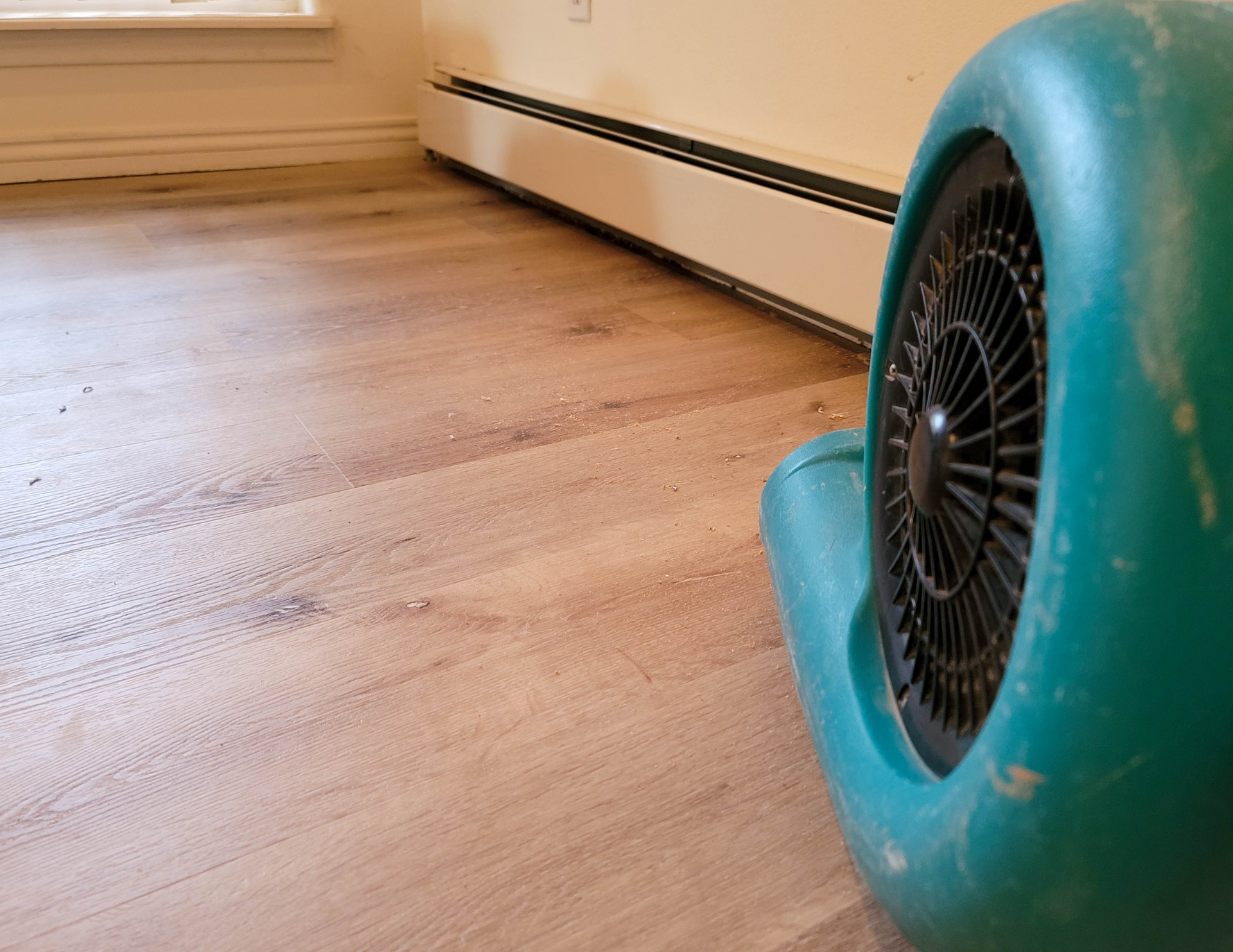
02 Nov, 2022
Water damage is a homeowner's nightmare, often necessitating professional intervention. However, the cost of water damage repair can vary significantly based on several factors. In this blog post, we'll delve into the factors influencing the cost of water damage repair, the importance of professional water leak restoration, and using a reliable water damage company, specializing in flood damage restoration and emergency water cleanup. Factors Influencing Water Damage Repair Costs • Extent of Damage: The severity of water damage is a major factor in determining repair costs. Minor water leaks that are quickly addressed may be less expensive to repair than extensive flood damage that requires extensive restoration. • Type of Water: The category of water involved (clean water, grey water, black water) affects costs. Black water, often found in sewage leaks, is the most expensive to handle due to the health risks it poses. • Material and Structural Damage: Repairs to damaged materials and structures like drywall, flooring, and ceilings can add to the overall cost. • Mold Remediation: If mold has developed due to water damage, the need for mold remediation services will increase the total repair cost. • Location of Damage: The location of the damage can also impact costs. Water damage in hard-to-reach or confined spaces may require additional labor and equipment. The Role of Water Damage Restoration Professional water damage restoration is essential to ensure a comprehensive and effective repair process. Water damage companies offer a range of services, including: • Water removal and extraction. • Drying and dehumidification to prevent mold growth. • Assessment of structural damage and necessary repairs. • Mold remediation and cleanup, if required. Reliable Water Damage Companies When facing water damage and concerned about repair costs, it's vital to connect with reputable water damage companies offering flood damage restoration, emergency water cleanup, and other services. That is where Dry Guard Restoration comes in. • Dry Guard Restoration is your go-to water remediation company in the Dallas/Fort Worth area. We can help you navigate the clean up and repair process. The cost of water damage repair can vary greatly depending on several factors. To budget effectively for water damage repair, it's important to consider the extent of the damage, the type of water involved, and the need for mold remediation. Prompt and professional water leak restoration is key to safeguarding your property and health. Call Dry Guard Restoration to ensure you get the professional help you need when it comes to flood damage restoration, emergency water cleanup, and more. Our team will help you navigate the repair process and ensure that your property is restored to its pre-damaged condition.
